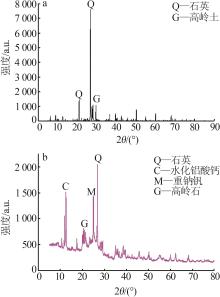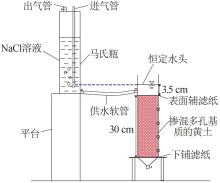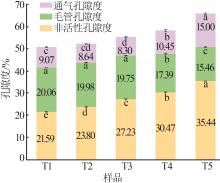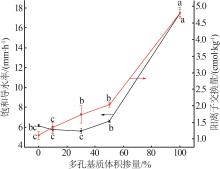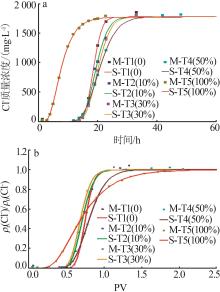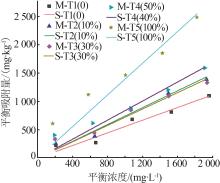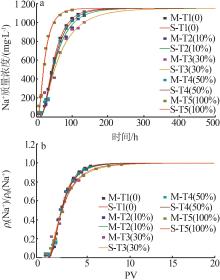Inorganic Chemicals Industry ›› 2024, Vol. 56 ›› Issue (9): 107-116.doi: 10.19964/j.issn.1006-4990.2024-0040
• Environment·Health·Safety • Previous Articles Next Articles
Effect of coal gangue-based porous matrix on soil solute transport
CHAI Chunjing1( ), FENG Zhengjun2, WU Haibin1, SHI Xiaokai3, ZHANG Junjie1, SONG Huiping1(
), FENG Zhengjun2, WU Haibin1, SHI Xiaokai3, ZHANG Junjie1, SONG Huiping1( )
)
- 1.Institute of Resources and Environmental Engineering,Engineering Research Center of Resource Efficiency Enhancing and Carbon Emission Reduction in Yellow River Basin,Ministry of Education of the People′s Republic of China,Laboratory of Shanxi Province for Yellow River,Shanxi University,Taiyuan 030006,China
2.Institute of Loess Plateau,Shanxi University,Taiyuan 030006,China
3.Shanxi Dadi Minji Ecological Environment Co. ,Ltd. ,Taiyuan 030012,China
-
Received:2024-01-22Online:2024-09-10Published:2024-09-26 -
Contact:SONG Huiping E-mail:156163875@qq.com;songhp@sxu.edu.cn
CLC Number:
Cite this article
CHAI Chunjing, FENG Zhengjun, WU Haibin, SHI Xiaokai, ZHANG Junjie, SONG Huiping. Effect of coal gangue-based porous matrix on soil solute transport[J]. Inorganic Chemicals Industry, 2024, 56(9): 107-116.
share this article
Table 3
Inversion of Cl- migration parameters in soil columns by CDE model"
| 样品 | 平均孔隙 流速(v)/(cm·h-1) | 水动力弥散 系数(D)/(cm2·h-1) | 弥散度(λ)/ cm | 佩克莱数 (Pe) | 决定系数(R2) | 均方误差 (MSE) |
|---|---|---|---|---|---|---|
| T1 | 1.599±0.025 | 0.343±0.188 | 0.215±0.123 | 139.700±60.455 | 0.998 | 1 167 |
| T2 | 1.525±0.044 | 0.611±0.191 | 0.401±0.136 | 74.838±29.307 | 0.994 | 3 273 |
| T3 | 1.473±0.061 | 0.580±0.332 | 0.394±0.251 | 76.156±36.985 | 0.999 | 485.2 |
| T4 | 1.423±0.084 | 1.003±0.564 | 0.705±0.460 | 42.567±22.902 | 0.999 | 492.3 |
| T5 | 3.524±0.323 | 11.496±0.729 | 3.262±0.435 | 9.196 ±1.451 | 1.000 | 133.5 |
Table 5
Inversion of Na+ migration parameters in soil columns by CDE model"
| 样品 | 延迟因子(R) | 平均孔隙 流速(v)/(cm·h-1) | 水动力弥散 系数(D)/(cm2·h-1) | 弥散度(λ)/ cm | 佩克莱数 (Pe) | 决定系数 (R2) | 均方误差 (MSE) |
|---|---|---|---|---|---|---|---|
| T1 | 2.466±0.007 | 1.334±0.084 | 7.170±0.926 | 5.376±1.043 | 5.581±1.074 | 0.996 | 787 |
| T2 | 2.806±0.018 | 1.335±0.129 | 8.760±1.528 | 6.562±1.690 | 4.572±1.071 | 0.990 | 1825 |
| T3 | 2.553±0.008 | 1.019±0.081 | 9.930±0.579 | 9.747±1.207 | 3.078±0.395 | 0.976 | 3959 |
| T4 | 2.611±0.025 | 1.324±0.107 | 7.590±0.644 | 5.732±0.954 | 5.234±0.809 | 0.991 | 1918 |
| T5 | 2.939±0.012 | 3.153±0.331 | 25.790±2.478 | 8.181±1.536 | 3.667±0.635 | 0.993 | 1519 |
| 1 | 胡振琪.矿山复垦土壤重构的理论与方法[J].煤炭学报.2022,47(7):2499-2515. |
| HU Zhenqi.Theory and method of soil reconstruction of reclaimed mined land[J].Journal of China Coal Society,2022,47(7):2499-2515. | |
| 2 | 郭拿拿,黄明斌,郭天崎,等.晋陕蒙地区土壤质地重构对土壤水力性质的影响[J].水土保持通报,2023,43(4):77-82. |
| GUO Nana, HUANG Mingbin, GUO Tianqi,et al.Effects of soil texture reconstruction on soil hydraulic properties in Shanxi-Shaanxi-Mongolia region[J].Bulletin of Soil and Water Conservation,2023,43(4):77-82. | |
| 3 | 郑鹏,党廷辉,薛江.粉煤灰、砒砂岩对煤矿排土场土壤水分特性改良的研究[J].土壤学报,2023,60(2):399-408. |
| ZHENG Peng, DANG Tinghui, XUE Jiang.Experimental study on the improvement of soil moisture characteristics of coal mine dump by fly ash and arsenic sandstone[J].Acta Pedologica Sinica,2023,60(2):399-408. | |
| 4 | 白东升.煤矸石堆积区生态重构模式与土壤水文性质优化的驱动要素[D].绵阳:西南科技大学,2022. |
| BAI Dongsheng.Ecological reconstruction model and driving factors of soil hydrological properties optimization in gangue accumulation area[D].Mianyang:Southwest University of Science and Technology,2022. | |
| 5 | 南益聪,杨永刚,王泽青,等.煤矸石对矿区土壤特性与植物生长的影响[J].应用生态学报,2023,34(5):1253-1262. |
| Yicong NAN, YANG Yonggang, WANG Zeqing,et al.Effects of coal gangue on soil property and plant growth in mining area[J].Chinese Journal of Applied Ecology,2023,34(5):1253-1262. | |
| 6 | 韩立鹤,尤勇刚,陆雅佩,等.模拟弃渣场不同重构土壤类型对高羊茅生长的影响[J].西部林业科学,2023,52(4):90-100. |
| HAN Lihe, YOU Yonggang, LU Yapei,et al.Effects of different reconstructed soil types on the growth of festuca elata in simulated slag field[J].Journal of West China Forestry Science,2023,52(4):90-100. | |
| 7 | 王乐,郭小平,韩祖光,等 .基于废弃物的潞安煤矿废弃地改良土壤基质配比研究[J].土壤,2020,52(1):145-152. |
| WANG Le, GUO Xiaoping, HAN Zuguang,et al.Study on formula of soil substrates for improving abandoned lands in Lu′an coal mine[J].Soils,2020,52(1):145-152. | |
| 8 | 胡振琪,康惊涛,魏秀菊,等.煤基混合物对复垦土壤的改良及苜蓿增产效果[J].农业工程学报,2007,23(11):120-124. |
| HU Zhenqi, KANG Jingtao, WEI Xiuju,et al.Experimental research on improvement of reclaimed soil properties and plant production based on different ratioes of coal-based mixed materi-als[J].Transactions of the Chinese Society of Agricultural Engineering,2007,23(11):120-124. | |
| 9 | 杨曦,朱健,刘方,等.电解锰渣改良基质对牧草生长及锰、镉淋溶迁移的影响[J].无机盐工业,2020,52(9):73-78. |
| YANG Xi, ZHU Jian, LIU Fang,et al.Effect of modified electrolytic manganese slag substrate on growth of pasture and leaching migration of Mn and Cd[J].Inorganic Chemicals Industry,2020,52(9):73-78. | |
| 10 | 胡振琪,李勇,陈洋.黄河泥沙在生态修复中的作用机理与关键技术[J].中国矿业大学学报,2022,51(1):1-15. |
| HU Zhenqi, LI Yong, CHEN Yang.The mechanism and key technology of the Yellow River sediment in ecological rehabilitati-on[J].Journal of China University of Mining & Technology,2022,51(1):1-15. | |
| 11 | 张玉锴,阎凯,李博,等.中国土壤重构及其土水特性研究进展[J].农业资源与环境学报,2023,40(3):511-524. |
| ZHANG Yukai, YAN Kai, LI Bo,et al.Research progress on soil reconstruction and soil-water characteristics in China[J].Journal of Agricultural Resources and Environment,2023,40(3):511-524. | |
| 12 | 宋慧平,安全,申午艳,等.固废基土壤调理剂的制备及其矿区生态修复效果[J].环境工程,2022,40(12):187-195,230. |
| SONG Huiping, AN Quan, SHEN Wuyan,et al.Preparation of solid waste-based soil conditioners and their ecological remediation effects on the mining area[J].Environmental Engineering,2022,40(12):187-195,230. | |
| 13 | ZHEN Q, ZHENG J, ZHANG X,et al.Changes of solute transport characteristics in soil profile after mining at an opencast coal mine site on the Loess Plateau,China[J].Science of the Total Environmennt,,2019,665:142-152. |
| 14 | GUO T, WANG Q, LI D,et al.Flow hydraulic characteristic effect on sediment and solute transport on slope erosion[J].Catena,2013,107:145-153. |
| 15 | MIN L, SHEN Y, PEI H,et al.Water movement and solute transport in deep vadose zone under four irrigated agricultural land-use types in the North China Plain[J].Journal of Hydrology,2018,559:510-522. |
| 16 | COMEGNA A, BELVISO C, RIVELLI A R,et al.Analysis of critical water flow and solute transport parameters in different soils mixed with a synthetic zeolite[J].Catena,2023,228:107150. |
| 17 | DELIN G N, LANDON M K.Effects of topography on the transport of agricultural chemicals to groundwater in a sand-plain setting[J].Hydrogelogy Journal,2002,10(4):443-454. |
| 18 | OKADA E, COSTA J L, BEDMAR F,et al.Effect of conventional and no-till practices on solute transport in long term field trials[J].Soil and Tillage Research,2014,142:8-14. |
| 19 | 邵明安,王全九,黄明斌.土壤物理学[M].北京:高等教育出版社,2006:206. |
| 20 | WANG L, GIUSEPPE B, CHRISTIAN Z,et al.Experimental and simulated microplastics transport in saturated natural sediments:Impact of grain size and particle size[J].Journal of Hazardous Materials,2024,468:133772. |
| 21 | ZHEN Q, MA W, LI M,et al.Effects of vegetation and physicochemical properties on solute transport in reclaimed soil at an opencast coal mine site on the Loess Plateau,China [J].Catena,2015,133:403-411. |
| 22 | ZHEN Q, ZHENG J, HE H,et al.Effects of Pisha sandstone content on solute transport in a sandy soil[J].Chemosphere,2016,144:2214-2220. |
| 23 | 王果.土壤学[M].北京:高等教育出版社,2009. |
| 24 | 白一茹,刘旭,张钰涵,等.生物炭对黄绵土中NO3 --N运移过程影响及模拟[J].环境科学,2024,45(5):2905-2912. |
| BAI Yiru, LIU Xu, ZHANG Yuhan,et al.Effect of biochar on NO3 --N transport in loessial soil and its simulation[J].Environmental Science,2024,45(5):2905-2912. | |
| 25 | 马小云,康小兵,王在敏,等.不同孔隙条件下饱和土壤内Cl-运移规律试验[J].实验室研究与探索,2018,37(12):30-33,67. |
| MA Xiaoyun, KANG Xiaobing, WANG Zaimin,et al.Cl- transport in saturated soils under different pore conditions[J].Research and Exploration in Laboratory,2018,37(12):30-33,67. | |
| 26 | PEI Y, HUANG L, LI D,et al.Characteristics and controls of solute transport under different conditions of soil texture and vegetation type in the water-wind erosion crisscross region of China’s Loess Plateau[J].Chemosphere,2021,273:129651. |
| 27 | 李荣磊,陈留美,邵明安,等.黄土高原不同土质和植被类型下Cl-运移特征及影响因素[J].土壤学报,2021,58(5):1190-1201. |
| LI Ronglei, CHEN Liumei, SHAO Ming′an,et al.Cl- transport and its influencing factors in soil as affected by soil texture and vegetation cover in Loess Plateau[J].Acta Pedologica Sinica,2021,58(5):1190-1201. | |
| 28 | 王浩越,陈宏信,冯世进,等.非平衡吸附条件下双分子反应性溶质运移规律研究[J].岩土工程学报,2023,45(12):2547-2555. |
| WANG Haoyue, CHEN Hongxin, FENG Shijin,et al.Migration of bimolecular reactive solutes considering nonequilibrium sorpti-on[J].Chinese Journal of Geotechnical Engineering,2023,45(12):2547-2555. | |
| 29 | 吴军虎,任敏.羟丙基甲基纤维素作土壤改良剂对土壤溶质运移的影响[J].农业工程学报,2019,35(5):141-147. |
| WU Junhu, REN Min.Effect of hydroxypropyl methyl cellulose as soil modifier on solute migration in soil[J].Transactions of the Chinese Society of Agricultural Engineering,2019,35(5):141-147. | |
| 30 | 李晓宇,任仲宇,李芳春,等.两种吸附模型对阿特拉津在壤质砂土中的模拟效果分析[J].农业环境科学学报,2020,39(1):191-200. |
| LI Xiaoyu, REN Zhongyu, LI Fangchun,et al.Analysis of simulated migration of atrazine in a type of loamy sand based on two adsorption models[J].Journal of Agro-Environment Science,2020,39(1):191-200. | |
| 31 | KOLAHCHI Z, JALALI M.Simulating leaching of potassium in a sandy soil using simple and complex models[J].Agricultural Water Management,2006,85(1-2):85-94. |
| 32 | MAZLOOMI F, JALALI M.Effects of vermiculite,nanoclay and zeolite on ammonium transport through saturated sandy loam soil:Column experiments and modeling approaches[J].Catena,2019,176:170-180. |
| [1] | MAO Shize. Study on microwave roasting-activated coal gangue to improve sulfate corrosion resistance of concrete [J]. Inorganic Chemicals Industry, 2025, 57(3): 86-93. |
| [2] | HAN Wei, SONG Yongming, LIU Qi, XU Jinling, XU Rong, LI Chunquan, YIN Shuaijun, SUN Zhiming. Study on performance of calcium chloride assisted thermal activation of coal gangue and its peroxymonosulfate activation toward benzo(a)pyrene degradation [J]. Inorganic Chemicals Industry, 2025, 57(1): 103-112. |
| [3] | WANG Lijuan, YAN Kezhou, GUO Zhiqiang, ZHAO Zhonghe, GUO Yanxia, CHENG Fangqin. Preparation of poly-aluminum chloride from acid leaching liquor of red mud-coal gangue activated by sodium salt [J]. Inorganic Chemicals Industry, 2023, 55(4): 76-83. |
| [4] | ZHANG Chenhu, MA Yi, ZHU Shan, CHEN Peng, WANG Chengyong, LI Ziwen. Study on adsorption of heavy metal ions in mineral processing wastewater by chelating modified coal gangue [J]. Inorganic Chemicals Industry, 2023, 55(4): 97-103. |
| [5] | Yang Quancheng,Zhang Kaiyong,Guo De,Shi Changsheng,Ma Ruixin,Tang Ligang,Du Zhenyu. Research on adsorption properties of methylene blue by mesoporous calcium silicate [J]. Inorganic Chemicals Industry, 2021, 53(10): 86-91. |
| [6] | Liu Xiaoting,Wen Jiuran,Wang Siyu,Liu Kaiping,Gao Ni,Zhong Jiaqiang. Study on strengthening technology of raw coal gangue aggregate [J]. Inorganic Chemicals Industry, 2020, 52(4): 65-71. |
| [7] | Yang Quancheng,Gong Zhiming,Mao Yanyu,Li Xiaodong,Zhang Yancheng,Shi Changsheng,Zeng Ming. Preparation of mesoporous calcium silicate with alumina-extracted coal gangue by hydrothermal method [J]. Inorganic Chemicals Industry, 2020, 52(11): 86-90. |
| [8] | Xie Juan,Xia Runnan,Du Hongxia,Xu Yongquan,Zhao Shuchun,Xu Hong,Kang Wentong. Preparation of α-Fe2O3/coal gangue composite photocatalyst and its application in pentachlorophenol degradation [J]. Inorganic Chemicals Industry, 2019, 51(5): 74-77. |
| [9] | Fan Jianming1,2. Study on sequential extraction experiment of aluminum and silicon from high alumina coal gangue [J]. Inorganic Chemicals Industry, 2019, 51(11): 65-68. |
| [10] | ZHANG Jin-Shan, SUN Chun-Bao, CAO Zhao, FAN Wen-Yang, GUO Zhen-Kun, FAN Xue-Min. Experimental research on preparation of metakaolin from coal kaolinite [J]. INORGANICCHEMICALSINDUSTRY, 2016, 48(9): 64-. |
| [11] | FAN Wen-Yang, LI Xia, SUN Jian-Ling. Research on synthesis of 4A zeolite with a coal gangue in Inner Mongolia at low temperature [J]. INORGANICCHEMICALSINDUSTRY, 2016, 48(5): 44-. |
| [12] | ZHANG Xiang, DUAN Jian-Bang, LI Rui-Ge, CHEN Miao, LU Yan-Jie. Preparation of polyaluminum chloride from calcium reducing slag and coal gangue [J]. INORGANICCHEMICALSINDUSTRY, 2016, 48(4): 66-. |
| [13] | . Experimental study on preparation of PAFS from acid leaching solution of high iron content coal gangue [J]. INORGANICCHEMICALSINDUSTRY, 2015, 47(6): 57-. |
| [14] | ZHAO Rui-Tong, WANG Jing, DUAN Xiao-Fang, FANG Li. Preparation technology of white carbon black from acid-leached residue of coal gangue [J]. INORGANICCHEMICALSINDUSTRY, 2015, 47(5): 53-. |
| [15] | XUE Fang-Bin, YANG Xi, GUO Yan-Xia, YANG Feng-Ling, CHENG Fang-Qin. Preparation of AlCl3·6H2O from acid leached solution of coal gangue by HCl gas sparging [J]. INORGANICCHEMICALSINDUSTRY, 2015, 47(4): 47-. |
| Viewed | ||||||
|
Full text |
|
|||||
|
Abstract |
|
|||||
|
||


